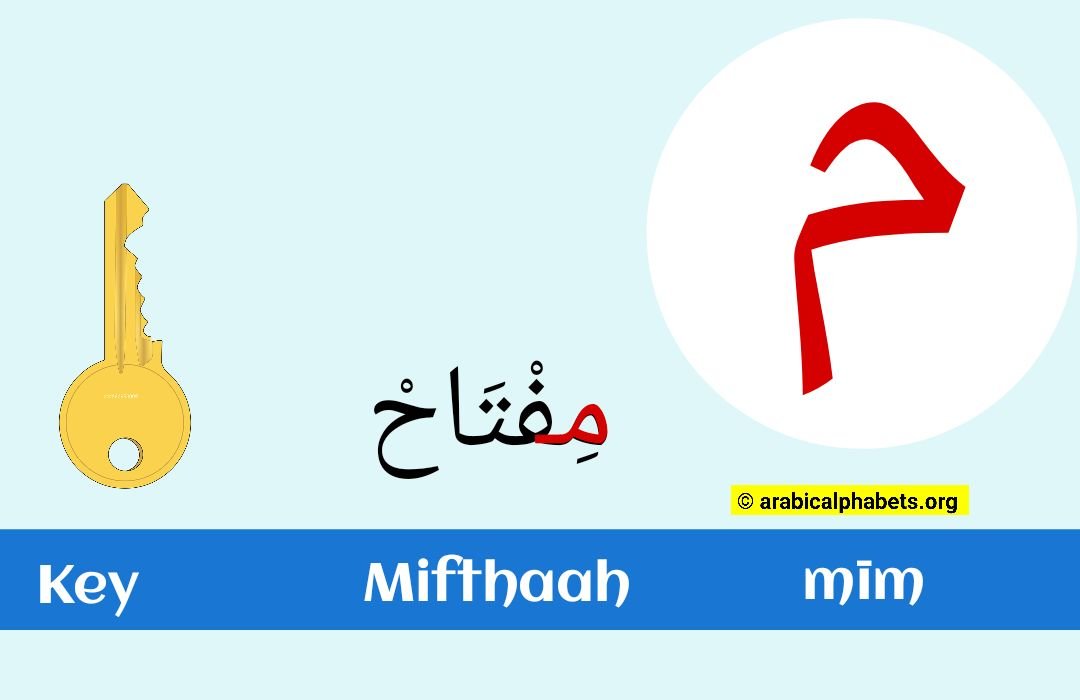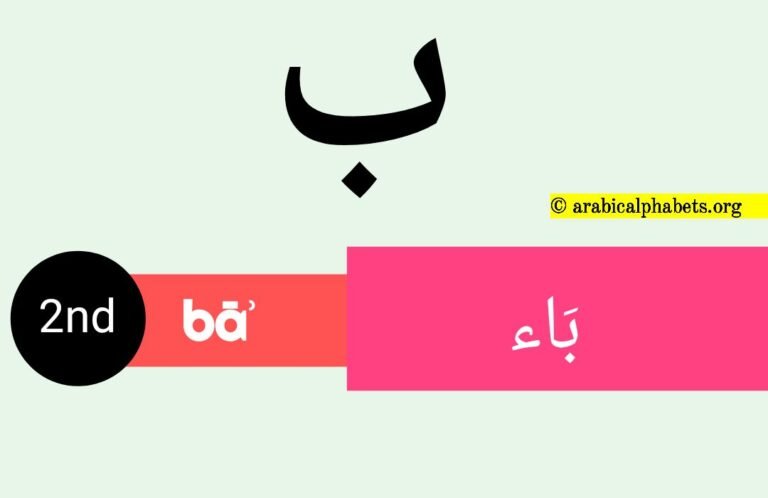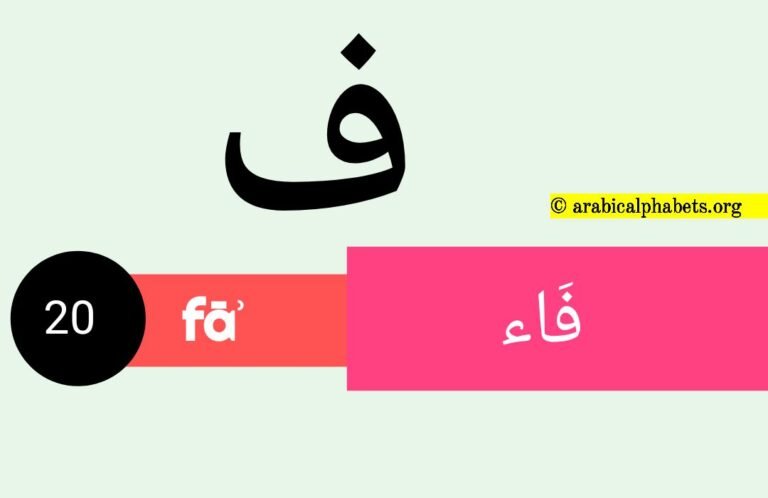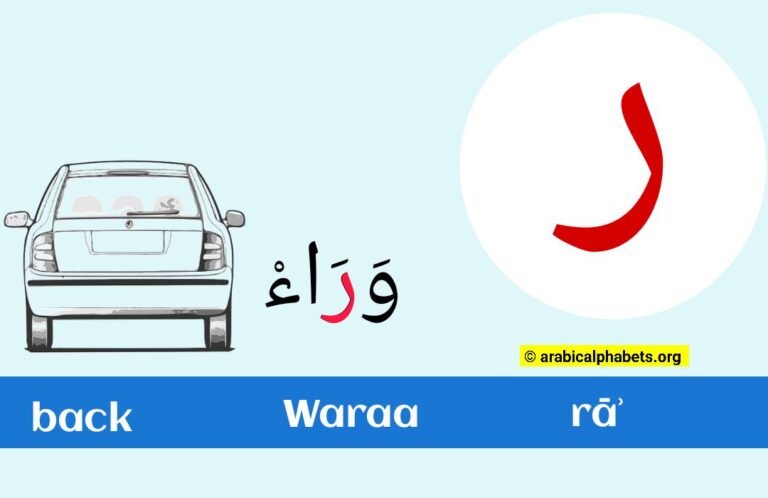Arabic Letter mīm – (م): Learn Everything
Welcome to our exploration of the Arabic letter “mīm – (م)”. This twenty-fourth letter of the Arabic alphabet is consonant with three contextual forms.
It is pronounced similarly to the English letter “m” but with a more emphatic, prolonged sound. In this article, we will take an in-depth look at this fascinating letter, examining its origin, history, and current usage.
Arabic Letter MIM (Short Description)
- Type – Consonants.
- Alphabetical Order – 24th.
- Contextual forms – three.
- Pronounce English letters like – mīm.
Welcome to a comprehensive exploration of the Arabic letter “Mīm” (م). This guide will give you an in-depth understanding of the letter’s pronunciation, form, usage, and cultural significance in Arabic.
1. Introduction to Mīm (م):
“Mīm” is the thirteenth letter of the Arabic alphabet. It carries a unique sound and appearance, contributing to the richness of the language.
2. Pronunciation:
The pronunciation of “Mīm” is a voiced bilabial nasal sound. To pronounce it, bring your lips together and release air while vibrating your vocal cords. It’s similar to the “m” sound in English words like “mother” or “moon.”
3. Letter Form:
The written form of “Mīm” (م) is a distinctive curved shape that stands out among the Arabic letters. Its form may change in cursive writing depending on its position within a word.
4. Initial, Medial, and Final Position:
“Mīm” can appear in different positions within Arabic words: initial (beginning), medial (middle), and final (end). Its form adjusts based on its position, contributing to the overall visual rhythm of the text.
5. Vocabulary and Words:
Numerous Arabic words begin with the letter “Mīm,” allowing you to build your vocabulary. Examples include “مدرسة” (school), “ماء” (water), and “معلم” (teacher).
6. Connection with Grammar:
Understanding the role of “Mīm” in grammar is essential for constructing sentences accurately. It may affect conjugations, agreements, and pronunciation patterns.
7. Cultural Significance:
Arabic has deep cultural roots, and each letter has historical and symbolic importance. Exploring the cultural context of “Mīm” can provide insights into the language’s role in literature, poetry, and daily communication.
8. Calligraphy and Art:
Arabic calligraphy is an art form where the shape of each letter is beautifully stylized. “Mīm” has a unique visual presence in various calligraphic styles, making it a popular choice for artistic expression.
9. Practice and Recognition:
Practice writing “Mīm” in its isolated form and within words. Enhance your recognition by reading Arabic texts and identifying the letter’s forms.
10. Further Learning Resources:
Explore textbooks, online courses, and language apps that focus on Arabic phonetics, writing, and grammar for a well-rounded understanding of Arabic letters.
11. Appreciation of Language:
Learning about individual Arabic letters, like “Mīm,” deepens your appreciation for the intricacies of the language. It’s a step toward linguistic proficiency and a broader understanding of Arab culture.
By delving into the nuances of the Arabic letter “Mīm,” you’re embarking on a journey of discovery within the realm of language and culture. Keep exploring, practicing, and applying your knowledge as you continue learning Arabic.
A – Serial Number, B – Isolated Form, C – Trans-literation, D – Letter name, E – Letter Name In Arabic Script.
م
| A | B | C | D | E |
|---|---|---|---|---|
| 24 | م | m | mīm | مِيم |
How to Pronounce Letter Meem
م ⬅️ میم
The letter Meem comes from the lips. Try to make the sound of this letter soft. Letter meem mainly three sounds –
- Ma – مَجَانِي (Majanee)
- Maa – أَمَامْ (Amaam)
- Mi – مِفْتَاحْ (Mifthaah).
How to Write Arabic Letters Meem?
The Arabic alphabet doesn’t have upper or lowercase letters like we see in the Latin alphabet letters. But the letters are combined when writing a word. However, each Arabic letter can be written in Contextual forms.
The Arabic letters of words are written and read from right to left, horizontally. There are four Contextual forms that each letter can take:
- Initial
- Medial
- Final
- Isolated (Detached).
| Contextual forms |
| Final | Medial | Initial | Detached |
|---|---|---|---|
| ـم | ـمـ | مـ | م |
You Must Know About Arabic Alphabet Letters
- The Arabic alphabet consists of 28 primary letters, although some authors include ء (hamza) as an additional letter, bringing the total count to 29.
- Arabic Letters have only three vowels, namely – (و،ا،ي) but ي and و, which can be both consonants and vowels, while Alif (،ا،) is only a pure vowel.
- In Arabic Alphabet, no capital and small letters.
Learn words that start with the Arabic alphabet letter Meem—interactive word picture for kids plus free printable resources for you.
Mastering the Arabic Language: Tips, Resources, and Effective Strategies
Embarking on the journey to master the Arabic language is exciting and rewarding.
Whether you aim to enhance your communication skills, delve into rich cultural nuances, or broaden your professional prospects, this guide provides a comprehensive roadmap to achieve fluency in Arabic.
1. Set Clear Goals:
Define your objectives for mastering Arabic. Are you aiming for conversational fluency, academic proficiency, or business communication? Clear goals will help you tailor your learning approach.
2. Embrace a Growth Mindset:
Approach Arabic learning with an open mind. Embrace mistakes as opportunities for improvement and stay motivated throughout your journey.
3. Choose Your Arabic Variety:
Decide between Modern Standard Arabic (MSA) and a specific dialect. MSA is used for formal communication, while dialects vary among regions for daily interactions.
4. Language Learning Resources:
Explore a range of resources such as textbooks, online courses, language apps, and podcasts. Mix and match resources to find the combination that suits your learning style.
5. Effective Study Habits:
Develop a study routine that includes consistent practice in reading, writing, speaking, and listening. Divide your study sessions into smaller, manageable segments.
6. Grammar and Vocabulary Mastery:
Master Arabic grammar rules, verb conjugations, sentence structures, and gender agreements. Gradually expand your vocabulary to express yourself more fluently.
7. Practice Active Listening:
Engage with Arabic media like podcasts, music, and videos to improve your listening skills and accustom your ears to the language’s rhythm and intonation.
8. Speaking Confidence:
Participate in dialogues with native speakers, language exchange companions, or language learning communities. Practice speaking regularly to build confidence and improve your fluency.
9. Cultural Immersion:
Immerse yourself in Arabic culture by exploring literature, films, and traditions. Understanding cultural context enhances your language comprehension.
10. Writing Practice:
Regularly write in Arabic, whether journal entries, essays, or emails. This will help reinforce your writing skills and grammar knowledge.
11. Tutoring and Language Partners:
Consider hiring a tutor or finding a language exchange partner who can provide personalized guidance and correction.
12. Stay Consistent and Patient:
Language mastery takes time. Participate in dialogues with native speakers, language exchange companions, or language learning communities.
13. Celebrate Milestones:
Acknowledge your achievements, whether holding a conversation, reading an article, or watching a movie in Arabic. Celebrate your progress!
14. Language Travel Opportunities:
Immerse yourself in an Arabic-speaking environment. Traveling to an Arabic-speaking country can provide real-world practice and cultural immersion.
15. Seek Community Support:
Join online language forums, social media groups, or local language meetups to connect with fellow learners and exchange tips and experiences.
By following these tips, utilizing diverse resources, and maintaining a consistent learning routine, you’re well on your way to mastering the Arabic language.
Embrace the challenges and joys of this linguistic journey as you build connections, expand your horizons, and enrich your life through language.
Conclusion Points
The Arabic language is an ancient form of communication that has been around for over a thousand years. One of its most recognizable features is the alphabet, which consists of 28 original letters.
The 24th letter in the alphabet is Mîm (م), one of the most important sounds in the language. It belongs to a group of “emphatic” consonants because they make a distinct sound when pronounced.
Mîm can be used in three different forms depending on where it appears in a word: medial, final, and isolated.
In its medial form, it produces an ‘m’ sound like English; however, when used with other letters as part of words, it can also produce a ‘b’ or even an ‘h’ sound, depending on context.
FAQs
What is the Arabic letter m? The Arabic letter m (م) is a consonant pronounced like the English letter m.
How do I write the Arabic letter m?
To write the Arabic letter m, start with a downward stroke from top to bottom and then add two slightly curved horizontal lines at the bottom.
What sound does the Arabic letter m make?
The Arabic letter m makes a nasal sound like the English word mother.
Can the Arabic letter m appear at the beginning of a word?
Yes, the Arabic letter m can appear at the beginning of a word, just like in words such as مدينة (Madinah – city) and ماء (maa’ – water).
Can the Arabic letter m be connected to other letters in writing?
Like most Arabic letters, the Arabic letter m can be connected to other letters when writing words.
Is there any difference between uppercase and lowercase versions of the Arabic letter m?
No, there is no distinction between uppercase and lowercase versions of the Arabic alphabet, including for the letter m.
Are there any similar-looking letters to the Arabic letter m?
No, there are no other letters in the Arabic alphabet that look similar to or have similar sounds as the letter m.
How do I pronounce words with multiple occurrences of the Arabic letter m?
When pronouncing words with multiple occurrences of the Arabic letter م, each occurrence should be pronounced individually without blending them.






